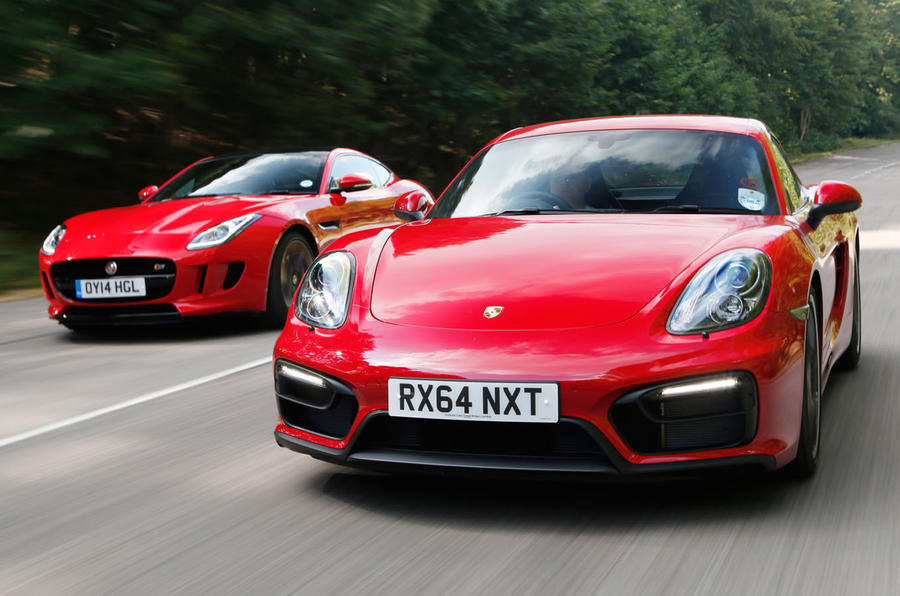Should you ever need proof that sports cars are getting better with every minute nowadays, the two you are looking at above will provide it with more than a little room to spare.
Because what strikes you about the Porsche Cayman GTS and Jaguar F-Type V6 S coupé – especially when they’re lined up beside one another, sporting similarly bright red paintwork, waiting metaphorically to lock horns – is that they are both such lovely-looking cars.
Deciding which one might be the better of the two is therefore likely to be an exercise in semantics, because this is a contest in which personal taste is always going to count for much.
However, there are key differences between them – quite dramatic ones in some cases. Besides, we at Autocar have never been all that happy to deliver a ‘horses for courses’ type of verdict, so separate them we shall attempt to do.
But before any opinion about what they do and how they differ from one another subjectively, let’s work out what they’ve got and how much they actually cost – because even here, there are elements that are far from straightforward.
The Cayman GTS, for instance, costs a seemingly fine-value £55,397 in its basic form, for which you get a 336bhp version of Porsche’s 3.4-litre flat six engine, an uprated chassis, PASM (Porsche’s electronic damping control system) as standard and a six-speed manual gearbox, among other goodies.
Factor in the options fitted to the test car, though – which include carbon-ceramic brakes, sports bucket seats, a limited-slip diff with torque vectoring and the no-cost optional sports chassis – and the price of the GTS soon heads towards the wrong side of £70k.
Read the Porsche Cayman GTS first drive review
And at that point, the Jaguar F-Type V6 S coupé, which initially appears to be the pricier of the two, at a whisker over £60k, actually becomes nothing of the sort.
Why? Because the Jaguar comes as standard with an eight-speed automatic gearbox, a limited-slip diff and a far better-appointed cabin, featuring most of the elements you need to pay extra for in the Cayman straight out of the showroom.
In reality, therefore, it is the Jaguar that is the cheaper of the two – by about £5k if you spec them like for like. So right there is one reasonably big difference to bear in mind.
As, of course, is the fact that the Jaguar’s V6 engine is supercharged and sits squarely between the front wheels, whereas the Cayman’s flat six is atmospheric and nestles lower in its chassis, behind the seats but well in front of the rear axle.
Front-engined versus mid-engined, supercharging versus atmo, manual gearbox versus automatic… already a picture is starting to emerge.



































































Add your comment
Rubbish comparison
It's all about the weight
Jaguar is my favourite maker so I hope it continues to go from strength to strength, but the F-Type is 250kg heavier and that should never have happened. In fact it is heavier than the 911 as well. So Jag's engineers cannot get 5 stars as a result, which is a shame because had they brought the car in at well under 1500kg as should have been the case all along - especially given that it is made of the much-vaunted alluminium - then it would have beaten the Cayman GTS in this test. As the figures below show, the Jag's 3-litre engine offers more power and torque than the Cayman GTS's 3.4 litre block, but then it has a lot more bulk to lug around. That is what makes the crucial difference.
So no excuses really, but perhaps Jag can continue working on the F-Type to work off that extra weight over time. It's a fantastic car but they may need to, and boost power from that engine too, because the proposed Alpha 6c looks stunning and the figures suggest Alpha are squeezing a huge amount of power out of its own V6 engine.
Porsche Cayman GTS
Kerb weight 1345kg; Engine 6-cyls 3436cc, Power 336bhp at 7400rpm; Torque 280lb ft at 4750rpm.
Jaguar F-type V6 S coupé
Kerb weight 1594kg; Engine V6, 2995cc, Power 375bhp at 6500rpm; Torque 339lb ft at 3500-5000rpm.
You can't go wrong